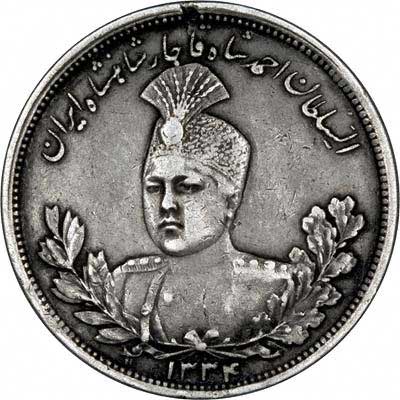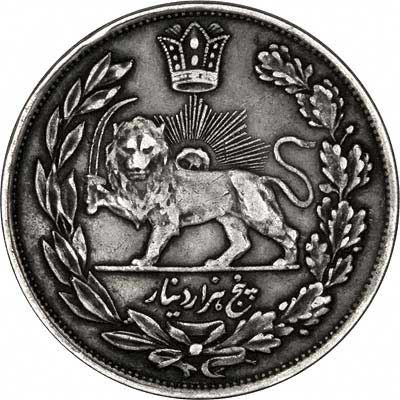| The Very Highest Quality Information... |
| Persian Coins |
|
| ||||||||||||||||||||||||||||||||||||
 Obverse of 1915 - 1916 Iran 5000 Dinars
| ||||||||||||||||||||||||||||||||||||
|
| ||||||||||||||||||||||||||||||||||||
 Reverse of 1915 - 1916 Persian 5000 Dinars
| ||||||||||||||||||||||||||||||||||||
Iran During the Dawn of Civilisation
Parts of what is now Iran formed parts of some of the earliest Empires originating from nearby Mesopotamia (in modern-day Iraq), including the Akkadian and Babylonian Empires, dating back to the Third Millennium BC and the very beginnings of recorded history. Iran was populated by several ethnic groups, including Medes, Persians, Parthians, Bactrians, Cimmerians, Sammartians and Alans.
The Rise of Persia
It was the Medes who were the first to form an Iranian nation, and the Median Empire, established in around 625 BC, included most of modern-day Iran and stretched from Cappadocia (in modern-day Turkey) to Bactria, near the River Indus (in modern-day Pakistan).
During this time, Persia was a vassal kingdom within the Median Empire, although the Persian and Median ruling dynasties were inter-related. Following a Persian revolt, Cyrus II, King of Persia, conquered Ecbatana, capital of the Median Empire, in 546 BC, founding the Achaemenid Empire as Cyrus the Great. The rise of the Persian Empire coincided with the rise of Zoroastrianism, a major monotheistic religion that would eventually become the national religion of Persia prior to the arrival of Islam.
Greek Conquest
The Achaemenid Empire, the greatest of its day, expanded under Cyrus and his successors to stretch as far west as Libya, as far east as the Indus. Under Xerxes, the Persian Empire tried to break into mainland Greece during the 480s BC, but was famously checked by the Spartans at the Battle of Thermopylae, and eventually repulsed.
Just over 150 years later, Alexander III, King of Macedon, conquered Persia and incorporated it into his Empire. When Alexander died, his empire broke up and the area now encompassing Iran was transferred to the successor Seleucid Empire until the Arascid Dynasty of the Parni tribe seized control of parts of the Empire (including Persia) and formed the breakaway Parthian Empire in 238 BC. The Arascid dynasty was a Scythian, rather than Hellenic dynasty, but the Parthians greatly admired Greek culture, and their coins were usually inscribed with Greek legends, often describing the King as a 'philhellene' (lover of all things Greek).
Sassanid Empire
In 224 AD, the Sassanian Dynasty, vassals of the Parthian Kings, overthrew the Arascids and re-established a culturally Persian Empire under Ardashir I.
The Sassanids inherited the Parthian's persistent conflict with the Roman Empire, often revolving around who controlled the client Kingdom of Armenia. This era of almost constant warfare lasted well into the Byzantine Age. In fact, this long-standing contest resulted in the eventual downfall of the Sassanids, not from the Byzantines themselves, but from Arab Muslims, who took advantage of the weakened Sassanids and over-ran Persia by 651 AD.
Islamisation
Under the rule of the Arab caliphates, the population of Persia was gradually converted to Islam. In other ways however, they fiercely resisted the kind of Arabisation that had been imposed on other territories conquered by the Umayyads, such as Egypt. The Persians retained their own distinctive language and culture, and even today, one could expect the average Iranian to get about as irritated at being described as an Arab as a Welshman would be at being described as an Englishman or a Canadian would by being described as an American.
This cultural divide is perhaps further heightened by the fact that Islam in Persia largely drifted towards the Shia branch, rather than the Sunni branch of Islam observed by most Muslims within the Arab world.
Re-emergence of Persia
Following the decline of the Abbasid Caliphate during the early Middle Ages, the Persian cultural identity began to reassert itself, and several native Iranian dynasties sprang up, including the Tahirids, Saffarids, Samanids, Afrighids, Ghurids, Sallarids, Justanids, Shaddadids and Buyids.
It was the Samanids who reconstituted much of Persia as an independent state during the 9th century, which was further consolidated by the succeeding Ghaznavid and Khwarazmian Dynasties during the Middle Ages.
Later Persian Empire
Under the Safavid, Afashrid, Zand and Qajar Dynasties, Persia remained a relatively antiquated state struggling to survive in an age of imperialism. During the 18th and 19th Centuries, Persia lost territory both to Imperial Russia and to British India, but resisted being fully absorbed by these colonial powers.
In 1925, the Qajar Dynasty was overthrown by Reza Khan of the Pahlavi Dynasty. Reza Shah tried to modernise Persia (which was renamed Iran in 1935) and turn it into a well-educated industrialised nation, which was partially successful. However, the Pro-German Reza Shah was overthrown in 1941 following an Anglo-Soviet invasion designed to provide a communication and supply link between the USSR and the British Empire during the Second World War. Reza Shah was replaced by his son, Mohammad Reza Shah.
Iranian Revolution
Iran was a constitutional monarchy however until 1953, when the popular Prime Minister, Mohammad Mosaddegh was overthrown by a CIA-MI6 backed coup in response to the nationalisation of the British Anglo-Persian oil company (the precursor of BP). The role of Britain and America in this coup against a popular leader who acted against western caused great resentment against the west amongst the Iranian population.
Following the coup, the Shah ruled as a virtual autocrat. His modernising and secularising reform program, known as 'The White Revolution' was a disappointment to those who hoped it would increase Iran's prosperity and a threat to the power of the religious clerics who had traditionally wielded a great deal of power over many areas of policy.
Iran degenerated into rioting, strikes and general disorder in August 1978 and as tensions exploded to a dangerous level, the Shah fled into exile in January 1979. The Ayatollah Khomeini returned the following month from exile in France as the Shah's regime collapsed an Islamic Republic was established within the year with a theocratic constitution giving Khomeini and the rest of the Islamic clergy almost dictatorial powers.
Islamic Rule
The popularity of the new regime was sealed by two events, the Iranian hostage crisis, during which the US failed in a military attempt to rescue hostages seized by the Iranian Government, and by the Iran-Iraq War of 1980-1988, when Saddam Hussein's Iraq attempted to annex Iran's oil-rich Khuzestan Province. The invasion rallied Iranians behind the revolutionary government, and even the former Crown Prince (a trained fighter pilot) offered to return to Iran to fight the Iraqis (although the offer was turned down). The war resulted in the status-quo antebellum, but Khomeini had succeeded in resisting foreign military interventions against Iran and as a consequence had made himself extremely popular amongst the Iranian people.
Post-Khomeini
The Ayatollah died in 1989, shortly after issuing a fatwa (Islamic judgement) against the British author Salman Rushdie for his controversial book 'the Satanic Verses'. Khomeini was widely and deeply mourned by the people of Iran. However, in recent years, the Islamic government has been subject to widespread rioting and demonstrations against theocratic rule which have been ruthlessly crushed.
Iran has recently been developing nuclear weapons, resulting in threats of military action by Israeli and western powers to stop them from completing their research and development in this area. At the time of writing, there is a deep sense of foreboding about the potential for a war against Iran in the not very distant future.
Coins of Iran
Coinage in Iran/Persia has a very long history, and is almost amongst the oldest. Arguably, the first coins in the world were invented in Lydia, western Anatolia (modern-day Turkey) but soon afterwards, Lydia was over-run by the Persian Empire, who adopted Lydian-style coinage themselves in the 6th Century BC, striking electrum (gold and silver alloy) staters, typically featuring a bearded king with a bow and spear.
The conquest of Persia by Alexander the Great brought Greek-style coinage to the region, particularly the Alexander tetra drachm featuring Herakles (Hercules) on the obverse and a seated Zeus on the obverse. Following the expulsion of the Seleucids in the third century BC, the Parthians largely retained the Greek coinage system based around the tetra drachm but with a uniquely Parthian style, particularly on the obverse, which featured a bearded king in Parthian costume. The reverse typically featured a seated archer surrounded by Greek script.
The overthrow of the Parthians by the Sassanids saw a radical change in the coinage reflecting the rise of a new Persian Empire. Greek script was replaced by Pahlavi script, and coins were typically flatter and wider.
The Arab invasion and takeover of the 7th Century AD saw the elimination of portraits and the adoption of Arabic calligraphy on Persian coins for centuries afterwards. Portraiture did not return to Persian coins until the 18th Century when it was reintroduced for certain commemorative issues of Nasser al-din Shah Qajar. The lion and the sun emblem became frequently used representation of imperial Persia on Iranian coins, lasting until the fall of the Shah in 1979.
The rial currency unit was first introduced in 1798 as a coin that was worth 1/8 of a toman* or 1,250 dinar. Silver coins of ¼, ½ and 1 rial were issued. However, this rial was discontinued in 1825, to be replaced by a decimalised currency, featuring a qiran worth 1,000 dinars.
This qiran was itself replaced at par by a new rial divided into 100 new dinars in 1932. Initially, coins of 1, 2, 5, 10, 25 dinar and ½, 1, 2, 5 were issued, and gold pahlavi (initially worth 100 rial) coins were also issued.
The pahlavi (later renamed azadi after the revolution) is a gold coin with the same gold content of a British gold sovereign, but of a slightly lesser alloy, and is therefore slightly larger and heavier.
*The toman is still used unofficially as a currency unit worth 10 rials.
For Sale and Wanted
If you are interested in coins from Iran please see our product index:-
Iranian Coins
Gold Coins
We also have gold coins from Iran on our taxfreegold website:-
Iranian Gold Coins
| ...at the Lowest Possible Price |
|
32 - 36 Harrowside, Blackpool, Lancashire, FY4 1RJ, England.
Telephone (44) - (0) 1253 - 343081 ; Fax 408058; E-mail: info@chards.co.uk The URL for our main page is: https://24carat.co.uk |
Web Design by Snoop |